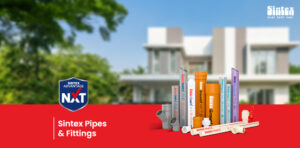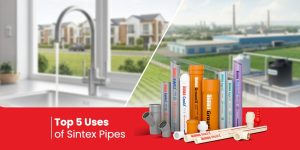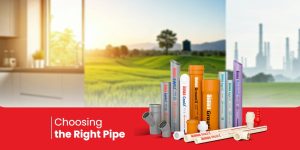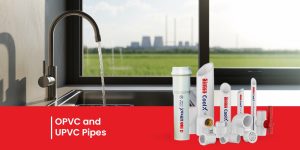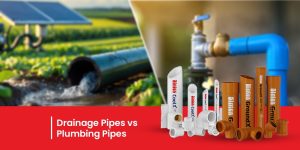Common Plumbing Mistakes and How to Avoid Them
Share
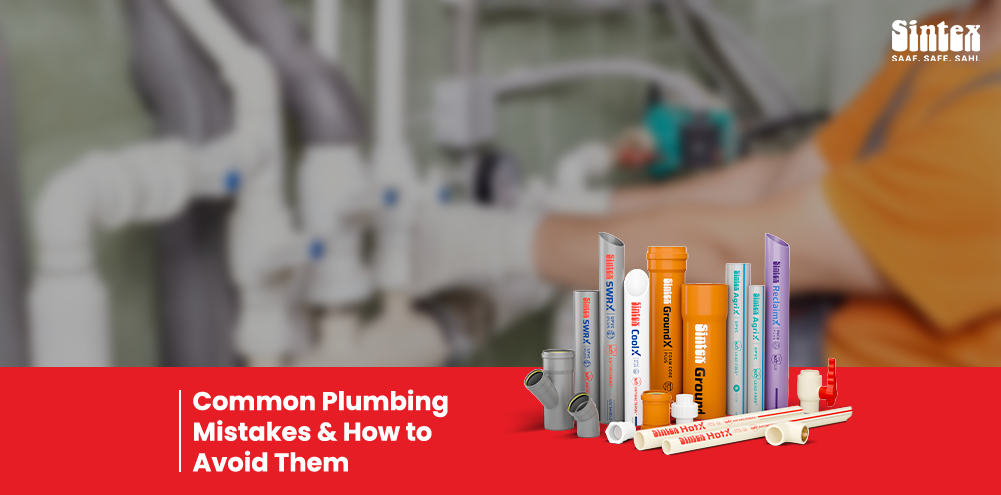
Table of Contents
Many plumbing problems come from simple mistakes like using the wrong pipes, poor fittings, ignoring slope in drainage, or not protecting against heat, chemicals, microbes, and rodents. These errors cause leaks, foul smells, and costly damage. Sintex offers smarter solutions with products like HotX CPVC for hot water, CoolX UPVC for cold water, DrainX HDPE for drainage, AgriX for agriculture, and SWRX UPVC Plus for rodent-proof sewerage. This blog will help you choosing the right pipe for the right job. So, you can avoid future issues and build a safe, long-lasting plumbing system.
If your water pressure is low, your pipelines make strange noises, or your bathroom constantly smells damp, chances are your plumbing system is paying the price for a few common mistakes. Whether you’re a homeowner, contractor, or DIY enthusiast, one wrong pipe connection or poor choice of material can create long-term plumbing nightmares.
Let’s discuss what can go wrong and how to keep it right. From PVC pipe and CPVC pipe choices to drainage pipe slope and fittings, this blog walks you through real, avoidable issues and the smarter alternatives.
Improper Pipe Selection
Every piping job isn’t the same. However, one of the most common mistakes is to utilise the same kind of pipe for all uses. Many people prefer plastic pipes due to affordability, without knowing they might not be good for water temperature, pressure, or chemical composition.
For instance, substituting a PVC pipe with a CPVC pipe can lead to warping or leakage. A CPVC pipe is employed where high temperature is required, e.g., in hot water systems. On the other hand, UPVC pipe is perfect for cold water and drinking water distribution.
Tip: Always understand the types of pipes and their properties before purchasing.
Poor Jointing and Loose Fittings
Even the finest quality PVC or HDPE piping will explode if the joints are not sealed. Applying the wrong sealant, installing fittings too crookedly, or failing to allow proper curing time can only serve to develop microscopic leaks that are undetectable until it’s too late.
That’s why brands like Sintex focus on high-quality brass fittings in products like HotX CPVC Plus Pipes and CoolX UPVC Pipes to ensure lasting, tight connections that don’t crack under pressure.
Ignoring Slope and Flow
This one’s especially important when laying out a drainage or reclaimed water pipe. The system must maintain a proper slope so waste or stormwater flows naturally.
Too flat? You’ll face stagnant water and foul smells. Too steep? Water will rush out too quickly, leaving solids behind.
Sintex’s DrainX HDPE channels are a great fix here. With smooth interiors and precision-built slope support, they handle flow without clogging or overflow issues.
Using the Wrong Pipe for Hot or Reclaimed Water
Not all water pipe materials are heat-resistant or suited for chemical exposure. Installing regular PVC pipe in hot water lines can cause deformation. Similarly, using non-resistant pipes for reclaimed water pipe systems will degrade the pipes internally over time.
This is where CPVC pipe (like Sintex’s HotX) or chemical-resistant HDPE pipes shine. They can withstand hot temperatures, harsh cleaning chemicals, and reclaimed water treatment.
Not Considering Anti-Microbial and Anti-Rodent Features
Let’s be honest: fungus and rodent damage aren’t just unpleasant; they can be expensive to fix. Traditional PVC pipe systems don’t offer any protection here.
Sintex gets this. Their AgriX pipe, CoolX UPVC, and SWRX UPVC Plus pipes have anti-microbial or anti-rodent features that keep your plumbing safe, clean, and long-lasting.
Tips to Get It Right with Sintex
They don’t just offer products; they provide problem-solving materials that minimise future damage and repairs.
- Use HotX CPVC Plus for hot water and bacteria resistance
- Install CoolX UPVC in your cold water supply for clean, corrosion-free flow
- Choose AgriX pipe for agriculture and drainage—it’s lightweight, rugged, and long-lasting
- Pick DrainX for safe, efficient outdoor surface water management
- Switch to SWRX UPVC Plus for rodent-proof sewerage setups
Not only does Sintex offer high-tech materials, but it also has safety features like UV protection, fire resistance, and chemical resistance.
Common Plumbing Mistakes vs. Better Choices
| Common Mistake | Impact | Smart Fix (Pipe Type) |
| Using PVC for hot water | Pipe warping and leaks | CPVC pipe like HotX |
| Poor slope in drainage | Water pooling and clogs | Use DrainX HDPE pipes with proper planning |
| Wrong pipe for chemicals | Corrosion and damage | Install HDPE pipe fittings or CoolX UPVC |
| Loose fittings | Leaks and pressure loss | Use brass fittings as in Sintex products |
| No anti-microbial tech | Bacterial growth and bad odour | Go for anti-microbial pipes like CoolX or HotX |
| Rodent damage in sewer lines | Cracks and blockages | Opt for SWRX UPVC Plus anti-rodent design |
Final Thoughts
Whether building a new plumbing system or rehabbing an old one, avoiding these common mistakes will save you money, time, and grief. Don’t just look at the cost of the PVC pipe and buy the cheapest one. Consider performance, safety, and overall value.
With Sintex’s revolutionary line of products, which can solve the plumbing issues of the real world, you can create long-lasting systems. For the assured solution, walk through their range of AgriX pipe, CoolX UPVC, HotX CPVC, DrainX, and HDPE pipe fittings.
Think ahead, plan smart, and choose innovative installations today to minimise repairs tomorrow. Choose right, install smart, and enjoy worry-free plumbing flow.
FAQs
PVC is for cold water and general use. CPVC pipe is used where hot water is needed, and thus can withstand more heat.
SWRX UPVC Plus by Sintex and HDPE pipes are rodent-, corrosion, and strength-proof, thus best used underground.
Consider the water temperature, pressure, and usage.
For hot and cold water, go with CPVC and UPVC pipe respectively. On the other hand, for chemical exposure, choose HDPE or OPVC pipes.
